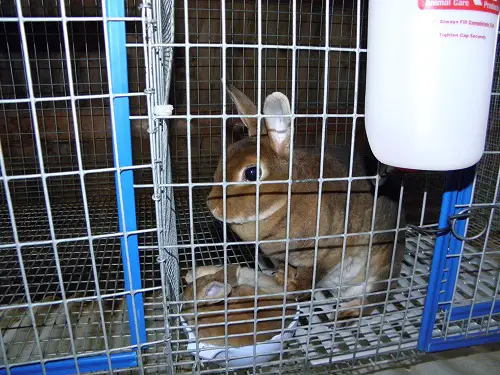By Laurie Stroupe
At a rabbit show recently, I was talking about giving my rabbits crocks. A very new breeder asked, “What’s a crock?” I suppose it’s short for crockery, since the original ones were probably all made of that. But simply put, it’s a dish. I was referring to water dishes in particular.
A crock should be either heavy or attached to the cage so that the rabbit cannot tip it over. I use several different types of crocks, depending on the situation. 
For young bunnies just getting out of the nest box, I use ceramic cat dishes. I want the sides to be low enough for a two- or three-week old rabbit to use easily. I also want them to be able to keep their heads above water should they decide to dive right in.
By the time they are about a month old, I move up to ceramic dog dishes. A litter can go through quite a bit of water, so the larger size accommodates that. Also, the rabbits are big enough by this age to keep their heads above water in the deeper dish.
As long as there are two or more rabbits sharing a cage, I keep them on a crock, despite each cage having an automatic watering fount.
There are other times that I use a crock in addition to the fount. First of all would be with any doe that is not producing as much milk as I would like her to. I don’t want her daintily licking the fount if she needs more water in her diet. Rabbits vary in their efficiency in using the automatic water (or even a water bottle), so I don’t want that to be an issue.
I also immediately give a crock to any rabbit that is not eating as many pellets as it normally would. Rabbits that don’t drink won’t eat. Any rabbit that I feel needs to gain weight is moved to a crock for the same reason. Eating and drinking are two sides of the same coin for rabbits.
I have a doe with four Grand Champion legs whose front teeth are beginning to look a bit twisted. I’ve put her on a crock just in case she is biting the stem of the watering system and causing her teeth to twist. It seems to me that I had a very nice buck in the same cage that also did that. I thought it was a genetic problem, but it might be a geographical one instead. I want to find out and I definitely want to see if this doe’s teeth can be naturally corrected by removing the suspected cause and adding a chew stick. We’ll see.
I use crocks with rabbits that seem to be having a difficult time learning how to use the watering system. Cristal, a black doe almost six month old, still doesn’t seem to have a clue. She will lick the water if I cause it to flow. She has worked every angle of that fount except biting the stem! I told her she should be embarrassed. I have three-week olds who can barely reach the fount using it with ease.
 Crocks are necessary for me when I have a rabbit on antibiotics. My normal practice is to put those rabbits on probiotics to counteract the side effects of the antibiotic.
Crocks are necessary for me when I have a rabbit on antibiotics. My normal practice is to put those rabbits on probiotics to counteract the side effects of the antibiotic.
Of course I have to use crocks when the water system freezes, and I also add crocks when the temperature gets about 93 degrees or so. Such temperatures are a challenge to rabbitries in general. I don’t want my bunnies having to cool themselves with a tiny fount. In addition to delivering plenty of water quickly, the crock is also something cool to lie against and can hold ice cubes, if needed.
I use crocks that attach to the side of the carrier when I travel. I hate that the crocks take up room in the carrier, but I like them much better than tiny water bottles. Perhaps if I showed a few rabbits only close to home, I would prefer the water bottles. But on long trips, refilling is required. I hated pulling each bottle, refilling it, and replacing it in the cage. It sounds easy until you have to do it 30 times! Now I use a metal watering can with a long spout. I can water all of my traveling rabbits in just a couple of minutes. I love it. Holland lops only need about ½ cup of water per day, so I only fill the travel crocks ½ full. That’s enough for their needs without having extra to slosh around in the car. I can top them off when I get to the showroom.
Don’t get me wrong; I love my watering system. Usually most of my cages are watered through the system. But I do not feel that relying solely on automatic water is the optimal way to manage my rabbitry.
